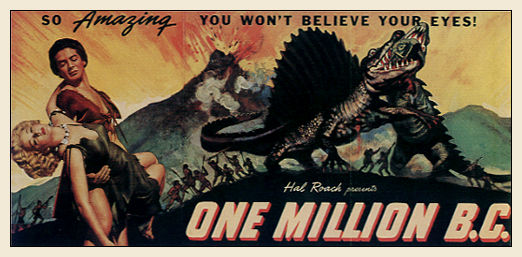

Notes: United
Artists, 80 minutes.
Tumak: Victor Mature
Loana: Carole Landis
Akhoba: Lon Chaney, Jr. [next year's Wolf
Man!]
Ohtao: John Hubbard
Nupondi: Mamo Clark
Peytow [not Peyton as The Magill Movie Guide
has it]: Nigel De Brulier
Tohana: Inez Palange
Skakana: Edgar Edwards
Ataf: Jacqueline Dalya
Wandi: Mary Gale Fisher
Narrator: Conrad Nagel
Produced: Hal Roach
Directed: Hal Roach and Hal Roach, Jr.
Screenplay: Mickell Novak, George Baker, Joseph
Frickert
Cinematography: Norbert Brodine and Roy
Seawright
Edited: Ray Snyder
Musical Score: Werner R. Heymann
Descriptive Narration: Grover Jones
Summary:
Rain forces a group of feckless wanderers into a cave where an
archeologist greets them. He has been studying "these markings
hidden for many centuries." In fact, he says, they tell
a "complete story. On this wall a learned man left his saga."
We're in for his "interpretation of the simple story left
here." Some dolt feeds him the line: "Do you mean there
were people of intelligence that long ago?" [And I'm lost
already. What is that supposed to mean? Somebody invented intelligence
in the 1920s?] Archeologist: "Intelligence, my friend, is
inherent. Education and culture are acquired. Civilization,
of course, has brought complications. But here are the same thoughts,
the same emotions, the same struggles with the problems of life
and death that, that we of today experience." [Okay, hold
on, Chuckles; so you're post-romantically reading emotion out
of cave drawings, fine, but what are we saying in 1940 about "The
War"?]
Mr. Gomless: "I always thought of those
ancient people as animals instead of humans." [Makes it
ethically easier to slaughter and eat them!] Fascinating. Anyway,
the "saga" concerns a "young hunter of one tribe
and a girl of another." The boy belongs to the Rock Tribe
and the girl the Shell People. "His was a cruel tribe.
Pity and compassion played little part in the existence of those
people, who ate only what they could kill; they depended solely
on their ability to kill for sustinence. They despised weakness,
worshipped strength. They ruled by the power of might. . . .
Animals were abundant; none of them had learned to fear man,
which made the hunter's life most hazardous. [You'd think it
would make being a hunter easier!] Here life lived hand in hand
with death. [???] And compensation came only to the strong."
We have faded into the prehistoric world, and
Tumak has killed a boar. Dire music accompanies the interminable
contentions over meat rights and ownership of chunks, and Tumak
ultimately fights with Akhoba, leader of the Rock Tribe, and falls
off a small cliff. A mastodon chases Tumak up a tree and butts
the tree into the water below. Tumak drifts unconsciously to
the Shell People and is discovered by a spear-fishing woman, Loana.
The Shell People take him in despite his uncouth ways, especially
his suspicion and pigginess regarding food. We see some wall-carving
going on and a baby bear stealing food.
Back among the hunting Rock Tribe, Akhoba is
battered by an ox, but staggers back to the cave. Hm . . . welfare
or tough luck?
The Shell People have a predator alert briefly.
But we soon focus on a meeting of the mimes as Loana and Tumak
teach each other their names. Tumak also gradually learns communism,
that is, he should share his food and help in the equal distribution.
A bit of a love triangle emerges with another Shell man, but
Tumak is valued for shaking trees to make fruit fall down. While
he fails to learn spear-fishing from Loana, a rubber-suited dinosaur
attacks the settlement and Tumak slays the animal. He struts
back to the others, but later fights his rival and is ordered
out of the tribe. Loana goes too.
On the odyssey, we encounter a slurpasaurus
[as later in The Lost World (1960); in other words, a regular
lizard with junky fins glued to him], we see a gigantic mongoose
haul off a gigantic snake, and an armadillo chases those crazy
kids up a tree. We also see two lizards fight each other, which
is real and pretty brutal, and enhanced by jungle screechings
and roars.
Blood wells at the neck of the losing lizard
when Tumak walks by. Loana blows her shell to signal trouble,
for the Rock Tribe are around. Reunion with Tumak's original
tribe involves lots of fighting, all tentatively smoothed out
by the two new peaceniks. Food other than meat is introduced
to an old man.
But wouldn't you know it, just when everything's
going so well, cataclysmic volcanic activity, lava, earthquakes,
etc. ravage the land. Lizards are panicked and tortured and it
looks as if they get burned too.
A lone shoe suggests to Tumak that Loana was
disintegrated by lava trying to save a cave-brat. But a horn-blowing
shows otherwise. Tumak's last heroism is saving a cornered batch
of cave-people from a gigantic iguana. He inspires them to harass
the animal, which roars and eats a guy, and then lures the iguana
away to where we can start an avalanche on top of it, underneath
which the creature is buried.
Hymnal sounds signal our glorious ending as
Tumak, Loana, and the cave-brat between them realize here comes
the sun and it's all right.
Commentary:
The ideological implications of the introduction are interesting
given the historical context--1940--but the introduction also
gives voice to the general attitude in all these dinosaur films
regarding this warped view of social Darwinism read back into
the prehistoric world. The film, nevertheless, shows favorably
the growing impulses towards civilized behavior. But this in
turn is undermined by the filmmakers' treatment of the lizards
used for dinosaurs. The cruelty is pretty upsetting.
